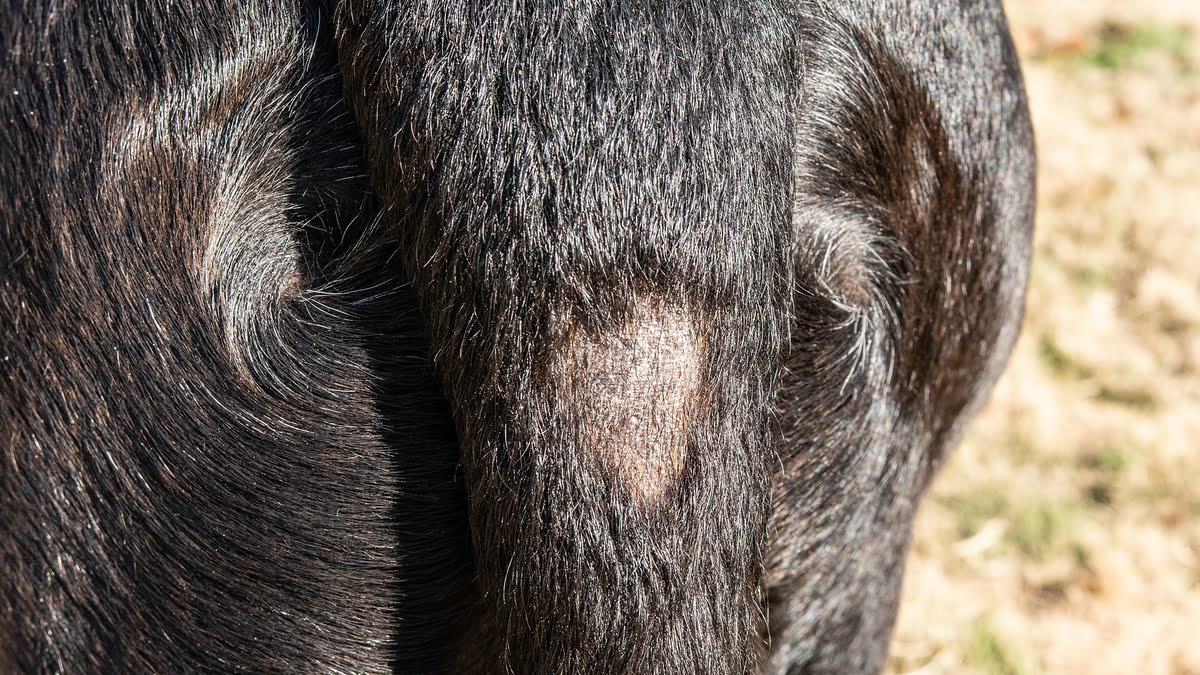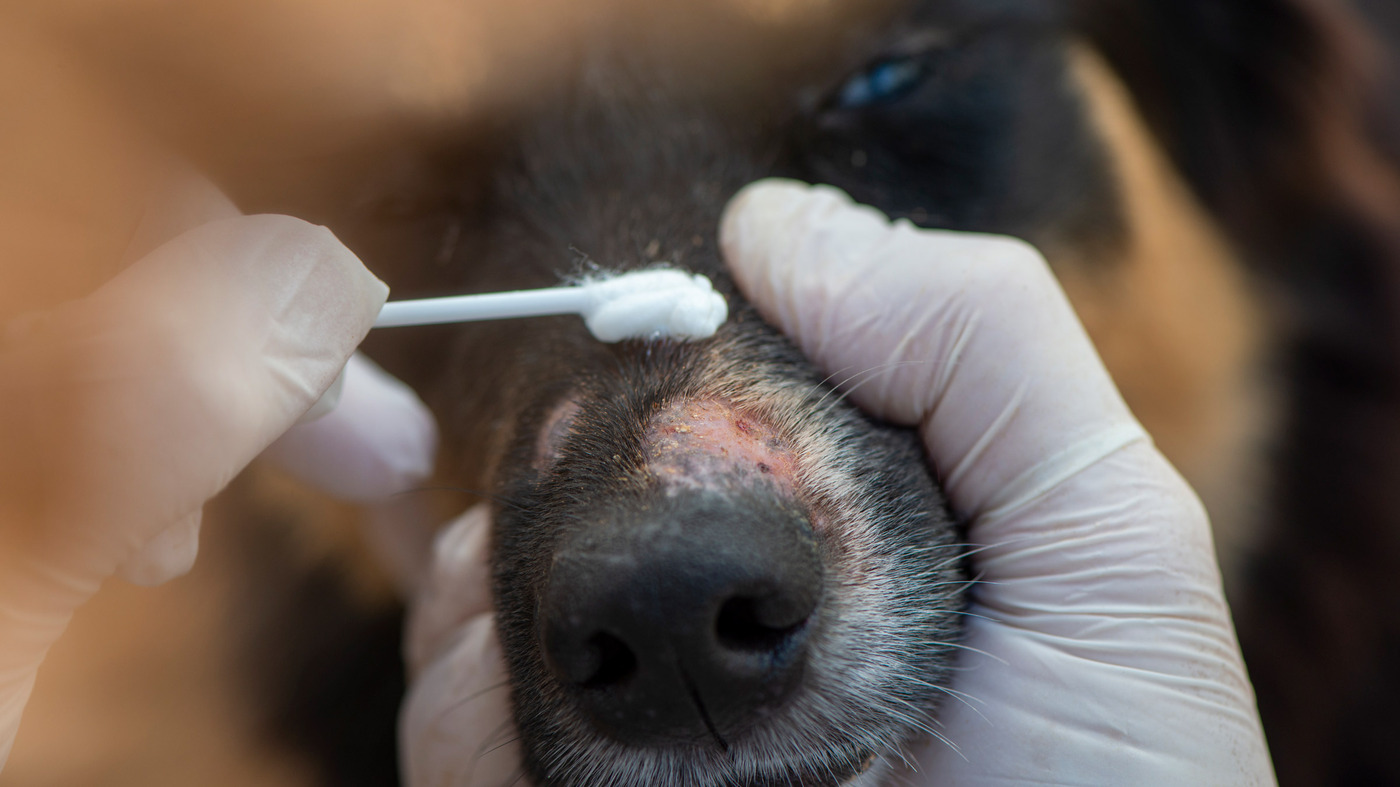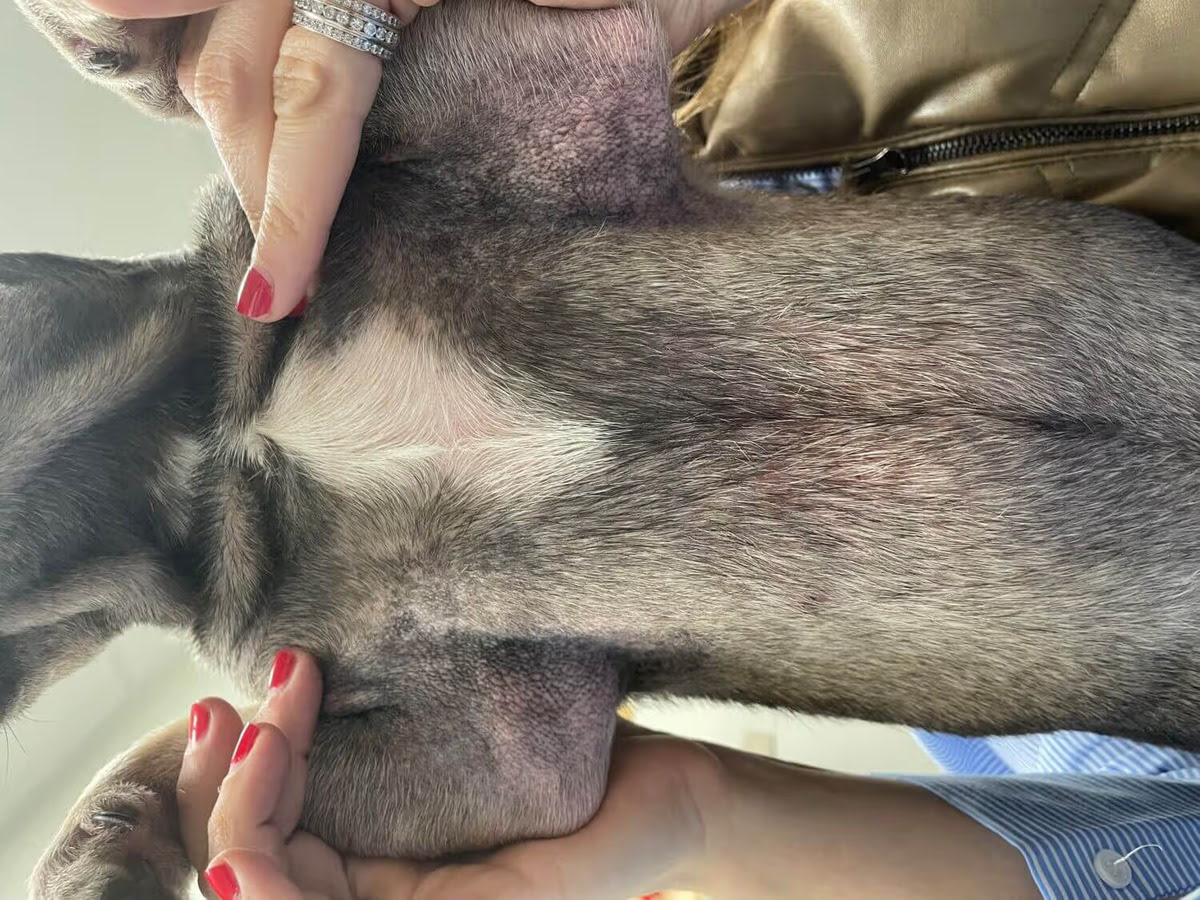Home>Health & Wellness>Common Health Issues>What Kind Of Parasite Causes Black Spots And Hair Loss On A Dog’s Skin


Common Health Issues
What Kind Of Parasite Causes Black Spots And Hair Loss On A Dog’s Skin
Published: February 7, 2024
Learn about common health issues in dogs, including the parasite that causes black spots and hair loss on their skin. Understand the symptoms and treatments for a healthier pet.
(Many of the links in this article redirect to a specific reviewed product. Your purchase of these products through affiliate links helps to generate commission for Pawsomeoldies.com, at no extra cost. Learn more)
Table of Contents
Introduction
Parasite infestations are a common concern for dog owners, often manifesting in various skin issues such as black spots and hair loss. These pesky organisms can wreak havoc on a dog's skin, causing discomfort and distress. Understanding the underlying causes of these symptoms is crucial for effective treatment and prevention.
In this comprehensive guide, we will delve into the world of parasites and their impact on dogs' skin health. By shedding light on the specific parasite responsible for black spots and hair loss, we aim to equip dog owners with the knowledge needed to identify, treat, and prevent these issues.
Parasites come in various forms, including fleas, ticks, mites, and lice, each capable of triggering a range of skin problems in dogs. By exploring the characteristics and effects of these parasites, we can gain a deeper understanding of the mechanisms behind black spots and hair loss on a dog's skin.
Join us as we embark on a journey to uncover the mysteries of parasite-related skin issues in dogs, empowering you to become a vigilant and informed advocate for your furry companion's well-being. Let's unravel the complexities of these pesky parasites and discover effective strategies to safeguard your dog's skin health.
Understanding Parasites and Their Effects on Dogs
Parasites are unwelcome guests that can wreak havoc on a dog's skin, leading to a myriad of issues such as black spots and hair loss. These tiny organisms, including fleas, ticks, mites, and lice, thrive by feeding on the blood and skin of their canine hosts. Their presence can trigger a range of adverse effects, causing discomfort and distress for the affected dogs.
Fleas, one of the most common parasites, are notorious for their ability to cause intense itching and skin irritation in dogs. When these pesky critters infest a dog's fur, they can lead to incessant scratching, which may result in hair loss and the formation of black spots on the skin. Additionally, flea bites can cause allergic reactions in some dogs, exacerbating the skin issues and further complicating the situation.
Ticks, another prevalent parasite, pose a significant threat to a dog's skin health. These blood-sucking arachnids can transmit various diseases, such as Lyme disease and ehrlichiosis, through their bites. In addition to the potential health risks, ticks can also induce localized skin irritation and inflammation, leading to hair loss and the development of black spots in the affected areas.
Mites, including sarcoptic and demodectic mites, are microscopic parasites that can profoundly impact a dog's skin. Sarcoptic mange, caused by sarcoptic mites, results in intense itching, hair loss, and the formation of crusty black spots on the skin. Similarly, demodectic mange, attributed to demodectic mites, can lead to patchy hair loss and skin discoloration, often manifesting as darkened areas on the dog's skin.
Lice infestations, although less common, can also instigate skin problems in dogs. These parasitic insects feed on the blood and skin debris of their hosts, causing skin irritation, itching, and hair loss. While lice infestations may not result in black spots, they can still induce significant discomfort and compromise the overall health of a dog's skin.
Understanding the diverse effects of parasites on a dog's skin is crucial for prompt identification and intervention. By recognizing the specific symptoms associated with different parasites, dog owners can take proactive measures to address these issues and alleviate their canine companions' discomfort. Through heightened awareness and vigilance, we can effectively combat the detrimental impact of parasites on dogs' skin health.
Identifying the Parasite Causing Black Spots and Hair Loss
Identifying the specific parasite responsible for black spots and hair loss on a dog's skin is paramount in devising an effective treatment plan. Different parasites can manifest in distinct ways, leading to varied symptoms that necessitate specific interventions. Understanding the characteristics and behaviors of these parasites is instrumental in pinpointing the root cause of the skin issues and facilitating targeted remedial measures.
Fleas, being a common culprit, can be identified through close examination of the dog's fur and skin. The presence of fleas may be indicated by the appearance of tiny, dark insects scurrying through the fur, along with the telltale signs of flea dirt – small, pepper-like specks that consist of digested blood excreted by fleas. Additionally, excessive scratching and the formation of small, red bumps on the skin are indicative of flea infestations, often accompanied by hair loss and the emergence of black spots in severe cases.
Ticks, on the other hand, can be visually identified by inspecting the dog's skin for the presence of engorged ticks or their characteristic small, round bodies. Ticks often attach themselves to the skin, particularly in areas with less fur coverage, and can cause localized hair loss and the development of black spots at the bite sites. It is crucial to exercise caution when removing ticks to prevent leaving behind any mouthparts, which can lead to secondary skin issues.
Mites, including sarcoptic and demodectic mites, can be challenging to identify without specialized equipment. However, the symptoms they induce can offer valuable clues. Sarcoptic mange, caused by sarcoptic mites, typically results in intense itching, hair loss, and the formation of crusty black spots, especially on the ears, elbows, and abdomen. Demodectic mange, on the other hand, may lead to patchy hair loss and the presence of darkened areas on the skin, often devoid of hair.
Lice infestations can be identified through meticulous inspection of the dog's fur, where the presence of lice eggs (nits) and adult lice can be observed clinging to the hair shafts. Lice infestations may not directly result in black spots, but the associated itching and hair loss can still cause significant discomfort for the affected dog.
By familiarizing themselves with the distinct characteristics and effects of these parasites, dog owners can effectively identify the specific culprit behind their pet's skin issues. This knowledge serves as a crucial foundation for implementing targeted treatment strategies and mitigating the impact of these pesky parasites on a dog's skin health.
Treatment Options for Parasite-Related Skin Issues in Dogs
Addressing parasite-related skin issues in dogs requires a multifaceted approach aimed at eradicating the underlying parasites, alleviating skin irritation, and promoting the restoration of healthy skin. The specific treatment options vary depending on the type of parasite infestation and the severity of the skin issues. By tailoring the interventions to the unique needs of each case, dog owners can effectively combat these pesky parasites and support their canine companions' skin health.
Flea Control and Treatment
For flea infestations, comprehensive flea control measures are essential to eliminate these persistent pests. Topical flea treatments, such as spot-on solutions and medicated shampoos, can effectively eradicate adult fleas and disrupt their life cycle. Additionally, oral flea medications provide systemic protection, targeting fleas at various life stages. Regular vacuuming of the living environment and washing the dog's bedding in hot water can help eliminate flea eggs and larvae, further curbing the infestation.
Read more: What Helps A Dog With Hair Loss From Fleas
Tick Removal and Prevention
Prompt removal of ticks is crucial to prevent the transmission of tick-borne diseases and minimize skin irritation. Tweezers or specialized tick removal tools should be used to grasp the tick as close to the skin as possible and gently pull it straight out. To prevent future infestations, topical or oral tick preventatives can be administered, offering ongoing protection against these blood-sucking parasites.
Mite Treatment and Management
Mite infestations, such as sarcoptic and demodectic mange, necessitate targeted treatment to eradicate the mites and alleviate the associated skin issues. Veterinary-prescribed parasiticides, including topical ointments and oral medications, are commonly employed to combat mite infestations. In severe cases, medicated shampoos and dips may be recommended to soothe the skin and aid in mite elimination.
Lice Eradication and Skin Soothing
Lice infestations can be addressed through meticulous grooming and the application of veterinary-recommended lice treatments. Medicated shampoos and topical solutions can effectively eradicate lice and their eggs, providing relief from skin irritation and promoting the restoration of healthy skin. Regular grooming and hygiene practices are crucial in preventing lice reinfestation.
Skin Health Support
In addition to targeted parasite treatments, supporting the overall skin health of the affected dog is paramount. This includes providing a balanced diet rich in essential nutrients, which plays a pivotal role in skin regeneration and immune function. Regular grooming and bathing with gentle, hypoallergenic shampoos can help soothe irritated skin and promote the regeneration of healthy skin and coat.
By implementing these comprehensive treatment strategies, dog owners can effectively combat parasite-related skin issues and restore their canine companions' skin health. It is essential to consult with a veterinarian to devise a tailored treatment plan that addresses the specific parasite infestation and the unique needs of the affected dog. Through diligent care and proactive measures, the impact of parasites on a dog's skin can be mitigated, fostering a healthier and more comfortable life for our beloved canine friends.
Preventing Parasite Infestations in Dogs
Preventing parasite infestations in dogs is a proactive endeavor that involves implementing comprehensive measures to safeguard canine companions from the detrimental effects of these pesky organisms. By adopting a multi-faceted approach to parasite prevention, dog owners can create a protective shield against fleas, ticks, mites, and lice, thereby promoting the overall well-being of their furry friends.
Regular Parasite Control Measures
Consistent and thorough parasite control is fundamental in preventing infestations in dogs. This includes the regular application of veterinarian-recommended flea and tick preventatives, such as spot-on treatments, oral medications, and collars. These products provide ongoing protection against parasites, effectively repelling and eliminating potential infestations. Additionally, environmental control measures, such as regular vacuuming and cleaning of living spaces, can help curb the proliferation of parasites in the home environment, further reducing the risk of infestations.
Routine Grooming and Hygiene Practices
Routine grooming and hygiene practices play a pivotal role in preventing parasite infestations and maintaining optimal skin health in dogs. Regular brushing and inspection of the dog's coat and skin can aid in the early detection of parasites, allowing for prompt intervention. Bathing with veterinarian-approved shampoos, specifically formulated to repel and eliminate parasites, can help fortify the dog's natural defenses against infestations. Moreover, maintaining a clean living environment, including regular washing of bedding and thorough cleaning of pet accessories, contributes to a parasite-free household.
Environmental Management
Effective environmental management is crucial in minimizing the risk of parasite infestations. This involves implementing measures to deter parasites from thriving in the dog's surroundings. For example, keeping outdoor areas well-maintained, including regular lawn mowing and vegetation trimming, can reduce the presence of ticks and fleas in the environment. Additionally, minimizing exposure to areas known to harbor parasites, such as wooded areas and tall grass, can lower the likelihood of infestations.
Read more: What Parasite Causes Pruritic In Dogs
Regular Veterinary Care and Preventative Measures
Regular veterinary check-ups are essential for proactive parasite prevention. Veterinarians can provide tailored recommendations for parasite preventatives based on the dog's unique needs and environmental factors. Furthermore, routine examinations enable early detection of potential infestations and the prompt implementation of preventative measures. Vaccinations and preventive treatments for specific parasites, such as heartworm disease, further fortify the dog's defenses against a range of parasitic threats.
Holistic Health and Immune Support
Maintaining the overall health and immune function of dogs is integral to parasite prevention. A balanced diet rich in essential nutrients, including omega-3 fatty acids and antioxidants, supports skin health and immune resilience, reducing the susceptibility to parasite infestations. Regular exercise and mental stimulation contribute to overall well-being, bolstering the dog's ability to fend off potential health threats, including parasites.
By integrating these proactive measures into their canine care routine, dog owners can effectively mitigate the risk of parasite infestations and promote the long-term health and comfort of their beloved pets. Through vigilance, consistent care, and collaboration with veterinary professionals, the impact of parasites on dogs can be minimized, fostering a thriving and parasite-free environment for our loyal companions.
Conclusion
In conclusion, understanding the impact of parasites on a dog's skin health is paramount for proactive care and intervention. The presence of parasites, including fleas, ticks, mites, and lice, can lead to a myriad of skin issues such as black spots and hair loss, causing discomfort and distress for our canine companions. By delving into the characteristics and effects of these parasites, we gain valuable insights into the mechanisms behind these skin problems, empowering us to take targeted measures to address and prevent them.
Identifying the specific parasite responsible for black spots and hair loss is a crucial step in devising effective treatment strategies. By familiarizing ourselves with the distinct signs and symptoms associated with different parasites, we can pinpoint the root cause of the skin issues and implement tailored interventions. This knowledge serves as a foundation for promoting the skin health of our furry friends and mitigating the impact of these pesky parasites.
Furthermore, addressing parasite-related skin issues in dogs requires a comprehensive approach that encompasses parasite control, targeted treatments, and skin health support. By eradicating the underlying parasites and alleviating skin irritation, we can facilitate the restoration of healthy skin and coat, promoting the overall well-being of our beloved pets.
Preventing parasite infestations in dogs is a proactive endeavor that involves regular parasite control measures, routine grooming and hygiene practices, effective environmental management, and holistic health support. By integrating these proactive measures into our canine care routine, we can create a protective shield against parasites, fostering a thriving and parasite-free environment for our loyal companions.
In essence, by arming ourselves with knowledge and implementing proactive measures, we can effectively combat the impact of parasites on a dog's skin health, ensuring that our furry friends lead healthy, comfortable, and fulfilling lives. Through vigilance, consistent care, and collaboration with veterinary professionals, we can create a safe and nurturing environment where our canine companions can thrive, free from the burdens of parasitic skin issues.












